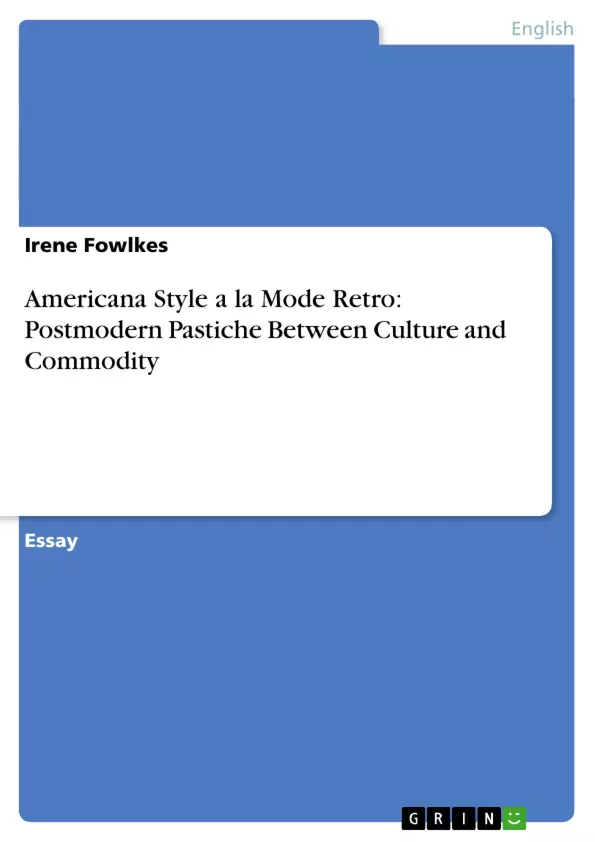An intriguing and controversial phenomenon in cultural theory is the fusion of high-and popular culture as characteristic of the postmodern period. Once provocative artists such as Brecht, Picasso and others had lost their subversive powers in school curricula and the museum and so were fully embraced by the bourgeoisie. In left wing reactionary fashion a new trend was born in British and American underground collectives, which aimed to incorporate the trivial and commercial into cultural expression. A new generation was on the move, which regarded an absolute distinction between elite–and mass production as extremely unhip. The most famous example is probably Andy Warhol’s pop art, which inevitably brings to mind stacked up Brillo boxes, Coca Cola bottles and Campbell soup cans, combining sophisticated painting techniques with mundane advertising images.
When measured against the "real" culture of modernism, postmodernism signifies a culture of kitsch in much of the approach conceptualized by the leading American theorist Fredric Jameson. He puts a distinctly political spin on the concept of postmodernism in his book 'Postmodernism or the Cultural Logic of Late Capitalism'. He views it as the "cultural dominant" of global capitalism. What has happened is that aesthetic production today has become integrated into commodity production generally as a result of American economic domination. As an example of the practice of this new culture, Jameson utilizes cinema, which he regards as the preeminent postmodern medium, due to its emphasis on sight. Particular reference is given to Hollywood productions of the late 20th century. As a representation of this genre, my selection includes American Graffiti (1973), Pulp Fiction (1994), True Romance (1983), Back to the Future (1985), Peggy Sue got Married (1986) and Rumble Fish (1983). After closely viewing these movies their aesthetic style will be related back to the concepts of Jameson’s theory. My analysis will be guided by the assumption, that many of the features of the theory essentially will be affirmed, ultimately illustrating that the distinction between high and low art has in fact vanished.
Inhaltsverzeichnis (Table of Contents)
- Introduction
- Main part 1: Features of theory
- Depthlessness
- Waning of affect
- Schizophrenia
- Pastiche
- Simulacrum
- Historicity
- Summary
- Main part 2: Movies
- American Graffiti (1973)
- Pulp Fiction (1994)
- Rumble Fish (1983)
- Back To The Future (1985) and Peggy Sue Got Married (1986)
- Conclusion
Zielsetzung und Themenschwerpunkte (Objectives and Key Themes)
The text aims to analyze the phenomenon of postmodernism, particularly its manifestation in film through the lens of Fredric Jameson's theory. It examines the fusion of high and popular culture as a defining characteristic of this period and explores how cinema reflects the "cultural logic of late capitalism".
- The evolution of cultural theory and the rise of postmodernism
- Jameson's theory of postmodernism and its key concepts, including depthlessness, pastiche, and the waning of affect
- The role of cinema as a postmodern medium, specifically through the analysis of "nostalgia films"
- The relationship between postmodernism and consumer capitalism
- The distinction (or lack thereof) between high and low art in the postmodern era
Zusammenfassung der Kapitel (Chapter Summaries)
The introduction delves into the fusion of high and popular culture during the postmodern period, tracing its origins and significance in cultural expression. It introduces the concept of postmodernism and its key theorist, Fredric Jameson, highlighting his Marxist perspective and his book "Postmodernism or the Cultural Logic of Late Capitalism".
The first main part focuses on Jameson's theory of postmodernism, outlining key concepts like depthlessness, waning of affect, schizophrenia, pastiche, simulacrum, and historicity. These concepts are illustrated through various examples, including visual art and cultural phenomena. The section concludes with a summary of these characteristics and their implications.
Schlüsselwörter (Keywords)
The primary focus of the text lies on exploring postmodernism, its cultural and theoretical manifestations, and its impact on cinema. Key terms include: postmodernism, cultural logic of late capitalism, high and popular culture, depthlessness, pastiche, waning of affect, simulacrum, historicity, nostalgia film, consumer capitalism, and Hollywood cinema.
- Quote paper
- Irene Fowlkes (Author), 2006, Americana Style a la Mode Retro: Postmodern Pastiche Between Culture and Commodity, Munich, GRIN Verlag, https://www.grin.com/document/128769



